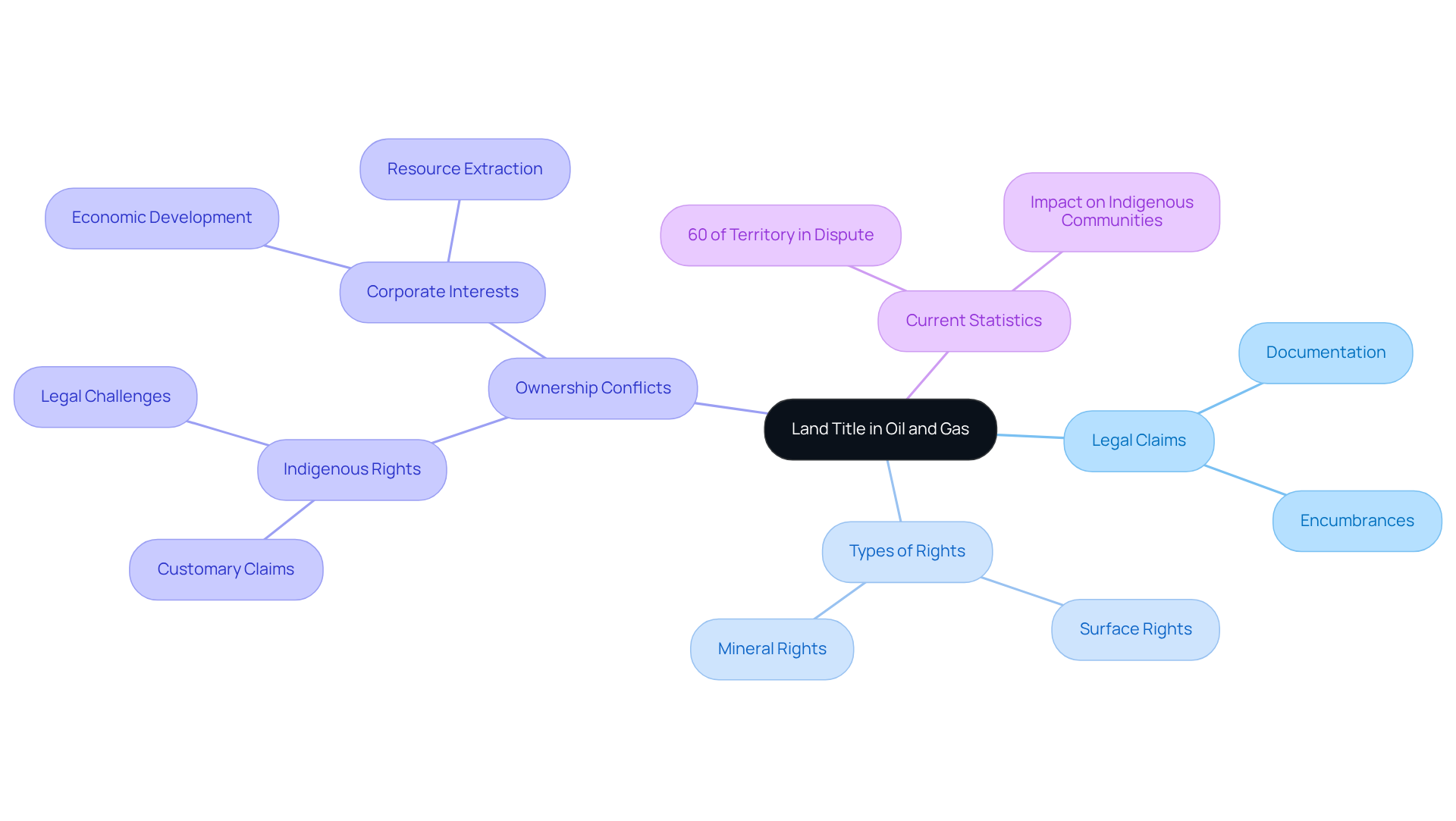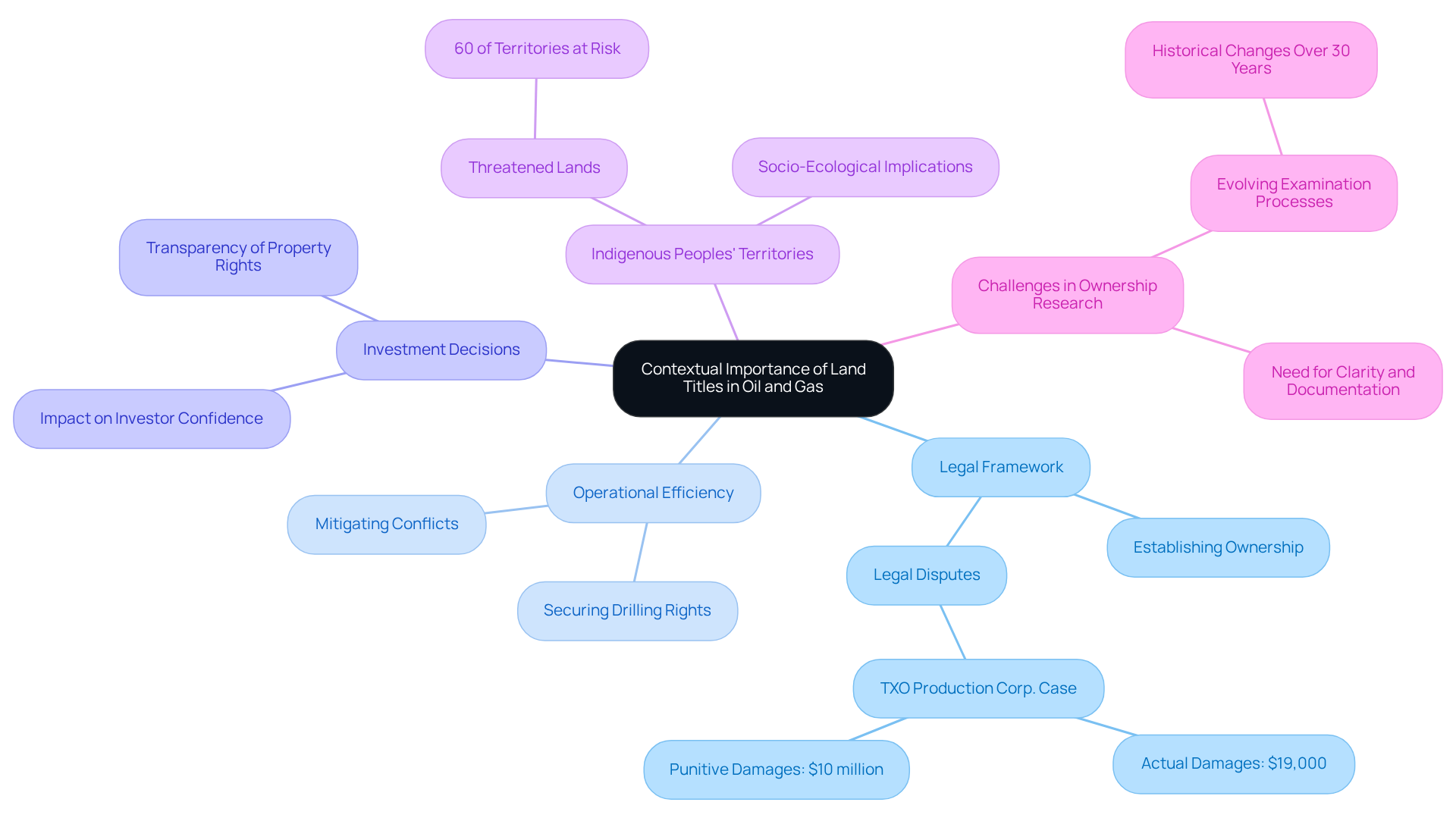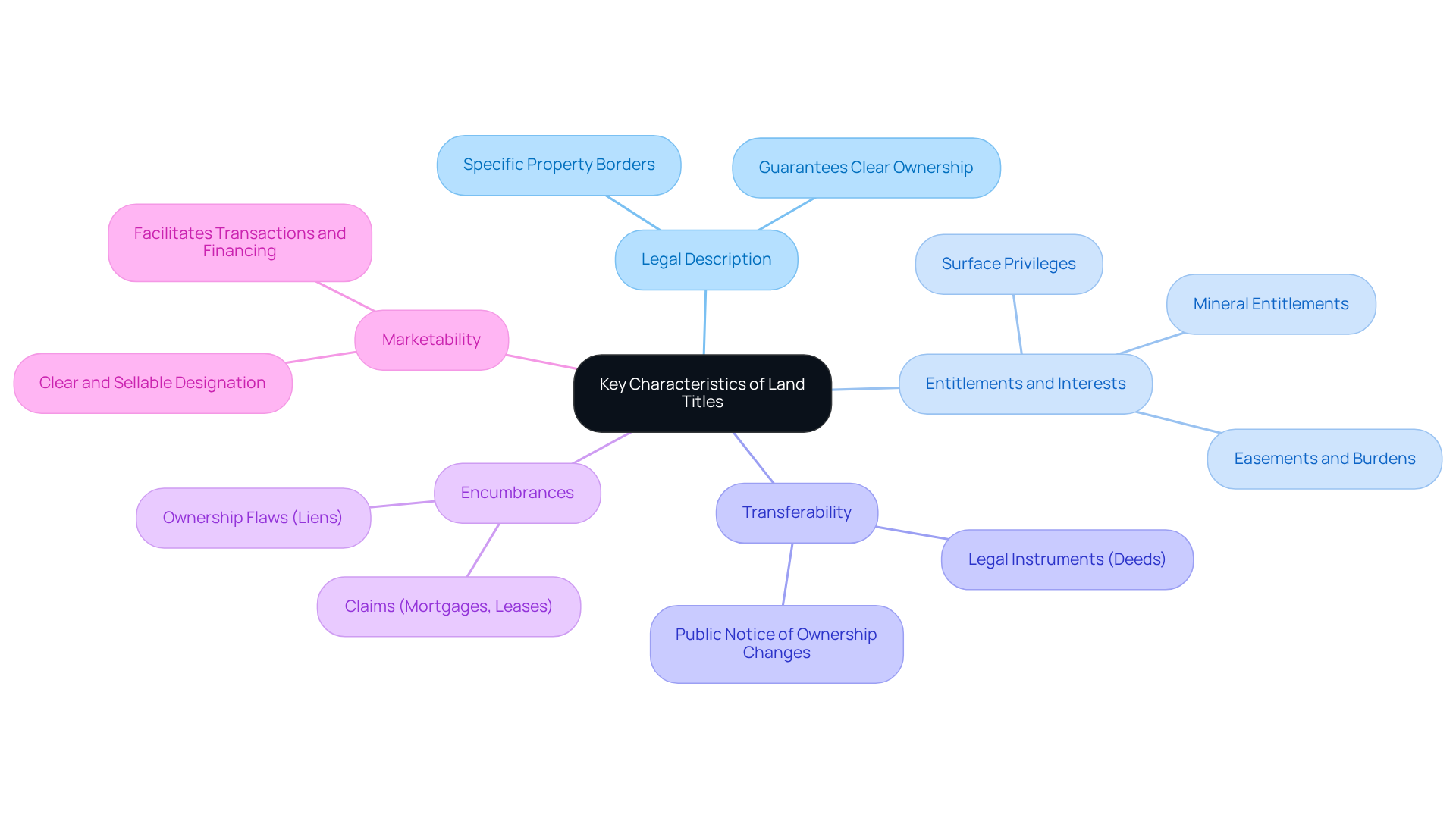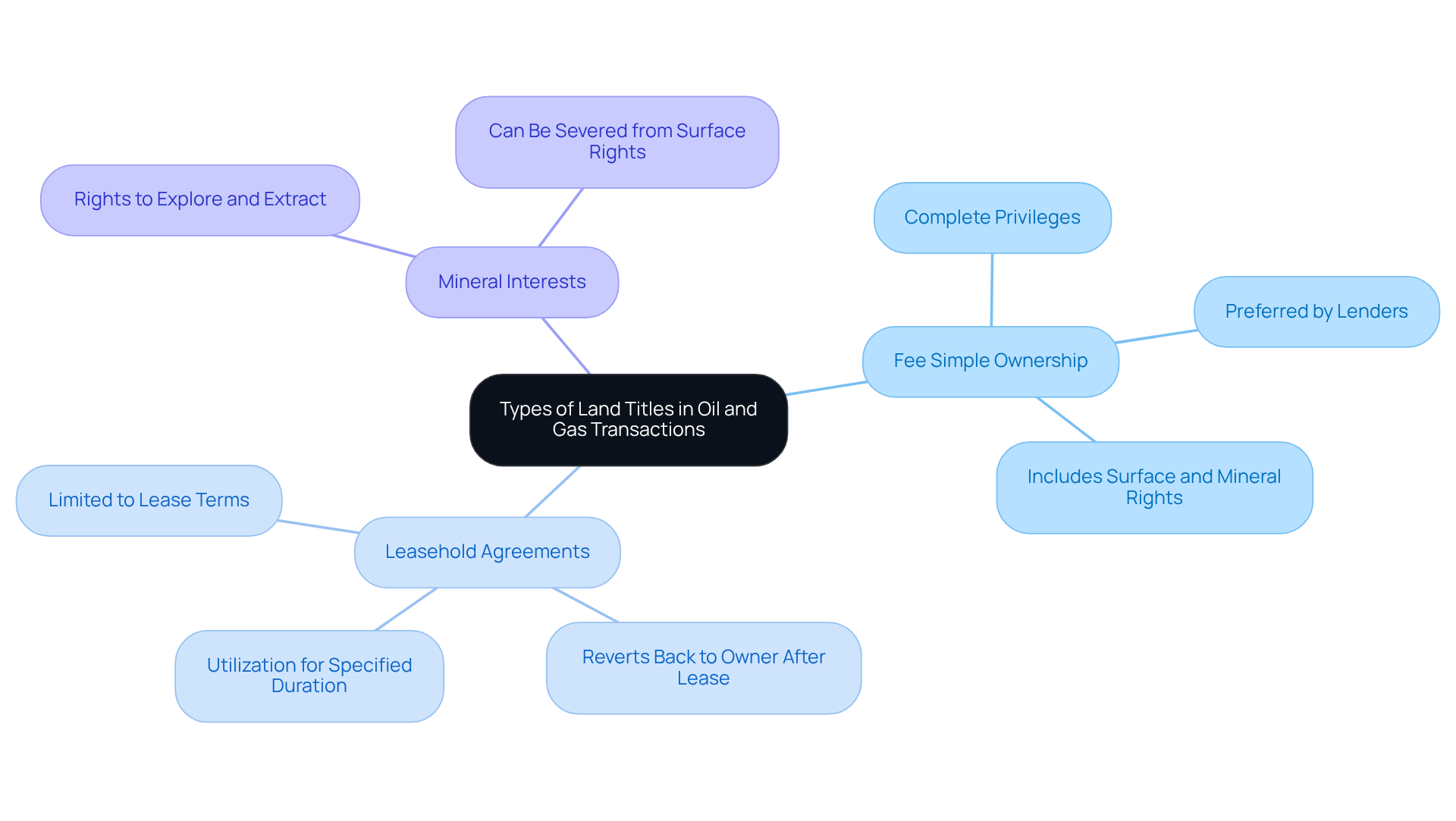Overview
Land title in oil and gas represents a legal claim to property that encompasses rights for exploration, extraction, and management of mineral resources. This aspect is critical for avoiding disputes and ensuring operational efficiency. Notably, approximately 60% of oil-rich territories are embroiled in disputes, underscoring the necessity for accurate land title management. Such management is essential not only for protecting investments but also for facilitating resource development. Clear property documentation plays a pivotal role in this context, enabling stakeholders to navigate complexities effectively.
Introduction
The intricate world of oil and gas hinges on a fundamental yet often overlooked concept: land title. This legal designation not only defines ownership of a property but also delineates the rights to explore and extract valuable mineral resources. As the industry grapples with rising disputes over property claims—often caught in the crossfire between corporate interests and Indigenous rights—the stakes for clear and documented land titles have never been higher. Furthermore, stakeholders must navigate this complex landscape to avoid costly conflicts and ensure seamless operations.
Define Land Title in Oil and Gas
What is land title in oil and gas signifies the legal claim to a specific tract of property, particularly concerning the permissions to explore, extract, and manage mineral resources, such as oil and gas. This designation encompasses various rights, including surface rights and mineral rights, which may be held separately. Legal documents meticulously record property ownership and any encumbrances, such as leases or liens, that could affect the asset. The importance of property ownership in the oil and gas sector is paramount, as it determines who possesses the right to utilize subsurface resources.
Legal specialists emphasize that a clear property ownership document is crucial for minimizing conflicts and facilitating smooth operations within the industry. Ownership conflicts can arise when multiple parties assert claims to the same property, leading to costly legal disputes. A striking example is the ongoing disputes surrounding property rights in oil and gas-rich areas, where customary claims by Indigenous communities frequently intersect with corporate interests. The Northern Gateway Pipeline project exemplifies this tension, underscoring the conflict between economic development and Indigenous rights.
Current statistics reveal that approximately 60% of territory in oil-rich regions is embroiled in some form of dispute, underscoring the critical need for clarity in property rights. As the industry evolves, understanding these dynamics becomes essential for stakeholders aiming to navigate the complexities of property ownership and resource extraction effectively.

Contextual Importance of Land Titles in Oil and Gas
In the oil and gas sector, understanding what is land title in oil and gas is essential, as land ownership documents are pivotal in establishing the legal framework for exploration and extraction activities. Well-defined and thoroughly recorded property documents are essential for firms to secure drilling rights and mitigate conflicts, thereby enhancing operational efficiency.
In regions abundant in mineral resources, the transparency of property rights significantly influences investment decisions, as investors seek assurances of ownership and compliance with regulatory standards. A notable case exemplifying this is TXO Production Corp. v. Alliance Resources Corp., where uncertainty surrounding property documents resulted in a substantial legal dispute, incurring $19,000 in actual damages and $10 million in punitive damages due to defamation of ownership. Such legal challenges underscore the importance of clear property ownership, which relates to what is land title in oil and gas, in facilitating seamless operations and attracting investment in the industry.
Furthermore, knowing what is land title in oil and gas is crucial for providing legal assessments based on well-defined property rights, ensuring that firms can adeptly navigate the regulatory landscape and minimize risks associated with ownership conflicts. Significantly, nearly 60% of Indigenous Peoples' territories are jeopardized by industrial development, highlighting the broader implications of clarity in property rights on investment choices.
The evolving nature of the oil and gas ownership examination process over the past 30 years has also transformed how ownership researchers tackle these challenges, reinforcing the necessity for ongoing enhancements in clarity and documentation.

Historical Development of Land Titles
The historical evolution of property claims in the United States is rooted in early real estate systems that established the legal framework for property rights. A pivotal moment occurred with the Land Ordinance of 1785, which initiated systematic property surveying and ownership registration, thereby setting a precedent for future regulations.
Over time, various regulations, including the Torrens System, emerged to simplify and protect property claims processes, enhancing the reliability of possession assertions. As the demand for oil and gas resources surged, it became essential to understand what is land title in oil and gas, leading to the development of property rights and the implementation of more stringent regulations and clearer definitions of ownership rights.
Understanding what is land title in oil and gas is essential for comprehending the complexities of property ownership within the contemporary oil and gas sector, as it illustrates the ongoing evolution of legal frameworks designed to meet the demands of a dynamic market.

Key Characteristics of Land Titles
Key characteristics of what is land title in oil and gas are crucial for stakeholders.
-
Legal Description: Each property document includes a specific legal description that distinctly outlines property borders, guaranteeing clear ownership.
-
Entitlements and Interests: Land ownership documents express the entitlements linked to the property, including surface privileges, mineral entitlements, and any easements or burdens that may be present. Surface entitlements provide the owner authority over the land's surface, while mineral privileges permit the extraction of resources beneath.
-
Transferability: Land ownership documents can be transferred through legal instruments such as deeds, which must be recorded to maintain public notice of ownership changes.
-
Encumbrances: Titles may be encumbered by various claims, such as mortgages or leases, which can influence the owner's rights and responsibilities. Ownership flaws, such as liens or unresolved claims, can complicate transactions and hinder resource development. Therefore, thorough ownership research is essential for stakeholders in the industry.
-
Marketability: A clear and sellable designation is vital for facilitating transactions and securing financing, as it assures potential buyers and lenders of the legitimacy of ownership. Understanding what is land title in oil and gas is indispensable for stakeholders in oil and gas operations, as it directly impacts their ability to explore and develop mineral resources.

Types of Land Titles in Oil and Gas Transactions
In the realm of oil and gas transactions, it is essential to understand what is land title in oil and gas, as various forms of property ownership are pivotal, including:
- Fee simple ownership
- Leasehold agreements
- Mineral interests
Fee simple ownership grants the holder complete privileges over the property and its resources. In contrast, a leasehold agreement allows a lessee to utilize resources for a specified duration under particular conditions. Furthermore, mineral rights titles specifically pertain to the rights to explore and extract minerals, which can be severed from surface rights.
Understanding what is land title in oil and gas is crucial for real estate professionals and energy companies, as it enables them to navigate the complexities of land ownership and resource extraction effectively.

Conclusion
Understanding the intricacies of land title in the oil and gas sector is crucial, as it fundamentally shapes the landscape of resource management and investment strategies. The clarity and legal definition of land titles dictate who possesses the right to explore and extract valuable minerals, playing a vital role in mitigating conflicts that can arise from overlapping ownership claims. Notably, nearly 60% of territories in oil-rich regions face disputes, underscoring the imperative for stakeholders to grasp the complexities of land ownership to avoid legal pitfalls and ensure sustainable operations.
This article outlines several key insights into the importance of land titles, including their historical development and the various types of ownership, such as fee simple ownership and leasehold agreements. It underscores the necessity of clear property documents for operational efficiency and attracting investment, as evidenced by notable legal disputes rooted in ambiguous ownership claims. Furthermore, the evolving nature of land title regulations reflects the industry's response to changing demands, particularly concerning Indigenous rights and corporate interests.
Ultimately, the significance of land titles in oil and gas extends beyond legal definitions; it encompasses broader implications for investment decisions, regulatory compliance, and social responsibility. Stakeholders are encouraged to prioritize clarity and thorough documentation in property rights to foster a more equitable and efficient resource extraction process. Embracing this understanding safeguards investments and promotes sustainable practices that respect the rights of all parties involved.
Frequently Asked Questions
What is land title in oil and gas?
Land title in oil and gas refers to the legal claim to a specific area that includes rights to explore, extract, and manage mineral resources like oil and gas. It encompasses surface rights and mineral rights, which can be held separately.
Why is understanding land title in oil and gas important?
Understanding land title is crucial as it determines property ownership significance in the sector and identifies who has the authority to utilize subsurface resources. It helps reduce disputes and facilitates smooth operations within the industry.
What are some common issues related to land title in oil and gas?
Common issues include ownership conflicts when multiple parties assert rights to the same property, which can lead to costly legal disputes. Disputes often arise in oil-rich areas where traditional claims by Indigenous communities overlap with corporate interests.
What percentage of territory in oil-rich areas is subject to disputes?
Approximately 60% of territory in oil-rich areas is subject to some form of dispute, highlighting the need for clarity in property ownership.
How can legal documents affect land title in oil and gas?
Legal documents record property rights, establish ownership, and outline any encumbrances, such as leases or liens, that may affect the asset. They are essential for clarifying the rights associated with land title.




